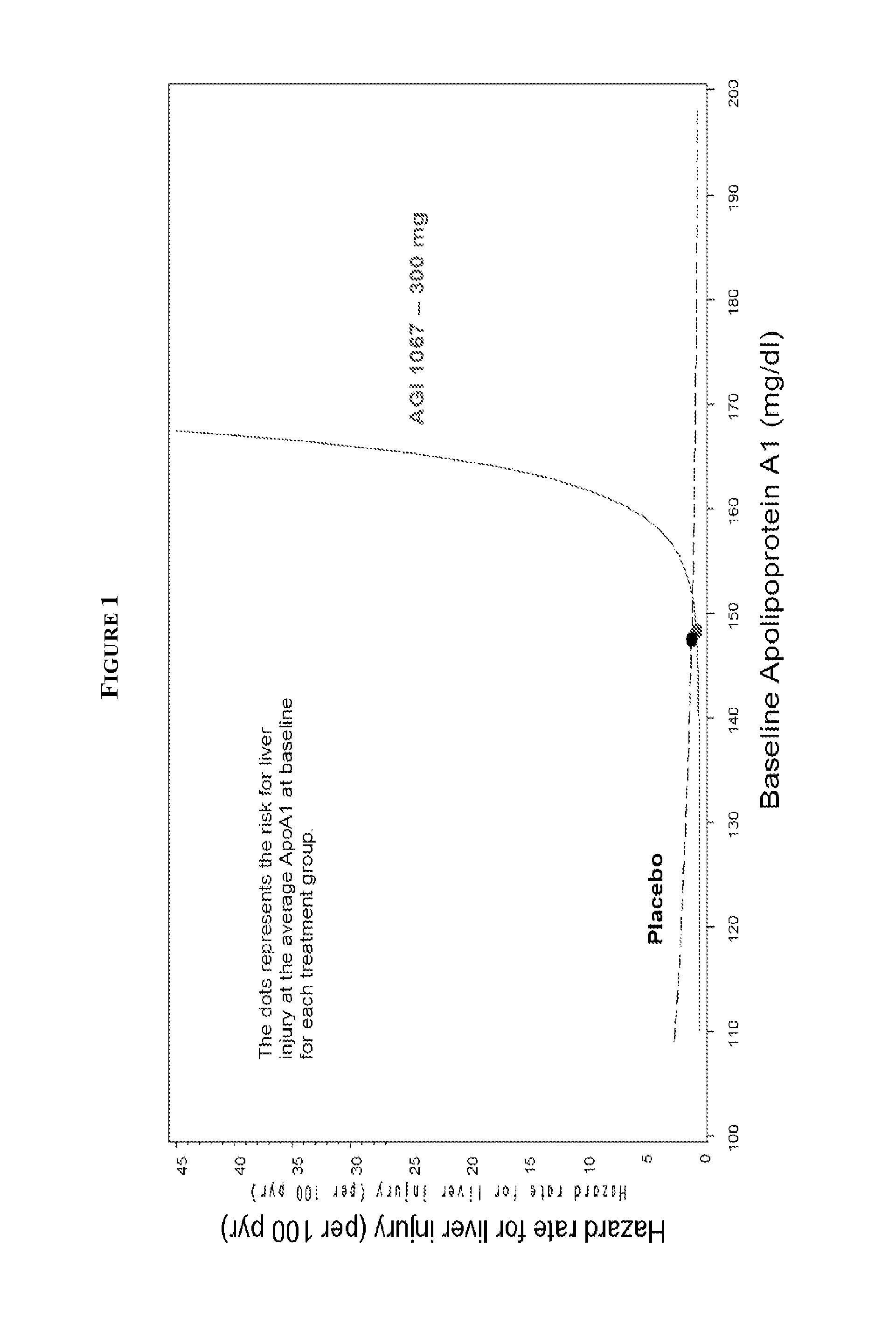Screening Method for Identifying Patients at Risk of Adverse Hepatologic Events
a screening method and liver injury technology, applied in the field of screening methods and kits for identifying patients who are at risk for liver injury, can solve the problems of increased risk of liver injury, and increased risk of drug-induced liver injury, and achieve rapid and reproducible effects
- Summary
- Abstract
- Description
- Claims
- Application Information
AI Technical Summary
Benefits of technology
Problems solved by technology
Method used
Image
Examples
example 1
ALT Elevation Alone Predicts Depatotoxicity Poorly
[0102]There were 36 patients who had peak elevations of ATL between 3× and ≦5× ULN in the combined dataset of diabetes mellitus patients. A summary of the data by treatment group is shown in Table 1. The incidence of ALT elevations in this range was comparable for the AGI-1067 and placebo treated groups of patients. ALT levels therefore appear to have limited value in assessing potential for hepatotoxicity.
TABLE 1Number ofPatientsALTPercent of3X to ≦ 5X ULNPercentRandomizedWithof ALTDiabetes PatientsTBL ≦ 2X ULNElevationsPlacebo43%1953%AGI-106757%1747% 75 mg9%38%150 mg9%411%300 mg39%1028%Total36
example 2
ALT Elevations in Combination with Total Bilirubin Levels is a Useful Indicator of Hepatic Events
[0103]There were 24 diabetes patients in the combined dataset who had hepatic events as using a criteria of either ALT >5× ULN plus TBL 3× ULN plus TBL >2× ULN criteria. Table 2 summarizes the patients by treatment arm and by dose of AGI-1067. At randomization, 57% of the patients were in the AGI-1067 arm and 43% were in the placebo arm resulting in an AGI-1067 to placebo ratio of 1.3. Of the 24 hepatic events, 17 occurred in AGI-1067 treated patients and 7 occurred in placebo treated patients.
TABLE 2BEFORE USE OF THE RISK IDENTIFICATION TOOLNumber ofHepatic EventsPercent ofALT > 5XALT > 3XRandomizedULN WithULN PlusPercent ofDiabetesTBL ≦ 2XTBL > 2XHepaticPatientsULNULNTotalEventsPlacebo43%43729%AGI-106757%1341771% 75 mg9%40417%150 mg9%2028%300 mg39%741146%Total17724
example 3
ApoA1 Levels are Directly Correlated to Adverse Liver Events
[0104]ApoA1 measurement was both sensitive and specific for identifying subsequent hepatic events. The events were defined as a measurement of ALT >5× ULN with TBL 3× ULN with TBL >2× ULN. FIG. 1 was generated from type 2 diabetes mellitus patient data shows age-adjusted effect for the 5th to 95th percentile range of baseline ApoA1 on subsequent liver events using a Cox Proportional Hazards Model. As a point of reference, the ULN for ApoA1 was 165 mg / dL for this trial. The solid line and the dashed line represent AGI-1067 and placebo data, respectively.
PUM
| Property | Measurement | Unit |
|---|---|---|
| hydrated density | aaaaa | aaaaa |
| hydrated density | aaaaa | aaaaa |
| sizes | aaaaa | aaaaa |
Abstract
Description
Claims
Application Information
 Login to View More
Login to View More - R&D
- Intellectual Property
- Life Sciences
- Materials
- Tech Scout
- Unparalleled Data Quality
- Higher Quality Content
- 60% Fewer Hallucinations
Browse by: Latest US Patents, China's latest patents, Technical Efficacy Thesaurus, Application Domain, Technology Topic, Popular Technical Reports.
© 2025 PatSnap. All rights reserved.Legal|Privacy policy|Modern Slavery Act Transparency Statement|Sitemap|About US| Contact US: help@patsnap.com

